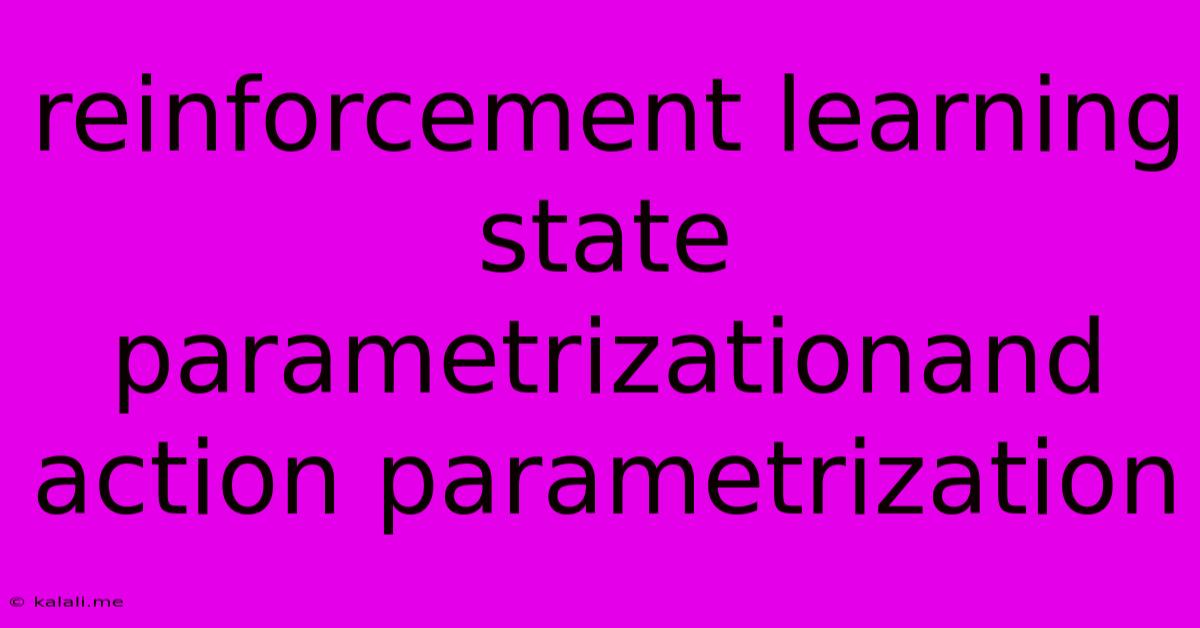Reinforcement Learning State Parametrizationand Action Parametrization
Kalali
May 25, 2025 · 4 min read

Table of Contents
Reinforcement Learning: Mastering State and Action Parametrization
Reinforcement learning (RL) is a powerful technique for training agents to make optimal decisions in complex environments. A crucial aspect of designing successful RL algorithms lies in effectively representing the environment's state and the agent's actions. This article delves into the intricacies of state and action parametrization, exploring various techniques and their implications for algorithm performance. Understanding these concepts is vital for anyone seeking to build effective RL agents.
What is State Parametrization?
State parametrization refers to the process of representing the environment's state using a set of numerical features. The state encompasses all relevant information about the environment at a given time. The choice of features significantly impacts the agent's ability to learn effectively. Poorly chosen features can lead to slow learning or even failure to converge to an optimal policy. Conversely, well-chosen features can dramatically improve learning speed and performance.
Techniques for State Parametrization:
-
Hand-crafted features: This involves manually designing features based on domain expertise. This approach is suitable for problems with well-understood state spaces, but it can be time-consuming and may not capture all relevant information. Examples include the position and velocity of a robot arm or the health points of a character in a game.
-
Feature extraction using dimensionality reduction techniques: Techniques like Principal Component Analysis (PCA) or t-SNE can reduce the dimensionality of high-dimensional state spaces while preserving important information. This can improve the efficiency of RL algorithms.
-
Raw pixel input (image-based): For visual environments, the raw pixel data from a camera can be used directly as the state representation. However, this approach often requires significant computational resources and robust algorithms like convolutional neural networks (CNNs) to process the high-dimensional input.
-
Embeddings from neural networks: Neural networks, especially deep learning models, can learn complex, high-dimensional feature representations from raw sensory data. These learned embeddings often capture crucial aspects of the state that are difficult to manually engineer. This is particularly useful for complex, unstructured environments.
What is Action Parametrization?
Action parametrization involves representing the agent's actions using a set of parameters. This is crucial because the agent needs a way to express its decisions numerically to the environment. Just as with state representation, the choice of action parametrization significantly impacts learning performance.
Techniques for Action Parametrization:
-
Discrete actions: The simplest form, where actions are represented as a finite set of choices. This is suitable for environments with a limited number of possible actions. Examples include moving left, right, up, or down.
-
Continuous actions: Actions are represented using continuous variables, allowing for finer control over the agent's behavior. This is often used in robotics and control problems, where smooth movements are necessary. Examples include the torque applied to a motor or the steering angle of a vehicle.
-
Parametric actions: Actions are defined by a set of parameters that are learned during training. This approach is common in robotics and allows the agent to learn complex action policies. For instance, the parameters might represent the coefficients of a polynomial function that describes the trajectory of a robot arm.
-
Stochastic actions: The agent selects actions probabilistically, introducing randomness into the decision-making process. This can help explore the state space more effectively and avoid getting trapped in local optima.
The Interplay Between State and Action Parametrization:
Effective RL heavily relies on the synergy between state and action parametrization. The chosen representations must be compatible and facilitate the learning process. For instance, using a high-dimensional state representation with a simplistic action space might be inefficient, just as using a complex action representation with a poorly defined state representation will hinder performance. Careful consideration of both is crucial for optimal algorithm design.
Choosing the Right Parametrization:
The optimal choice of state and action parametrization depends heavily on the specific RL problem being addressed. Consider these factors:
- Complexity of the environment: Complex environments often require more sophisticated representation methods.
- Computational resources: High-dimensional representations demand more computational power.
- Learning algorithm: Different RL algorithms have different requirements for state and action representations.
- Interpretability: Sometimes, simpler representations are preferred even if they are less accurate, to increase the understanding of the learned policy.
Effective state and action parametrization are crucial for successful reinforcement learning. Careful consideration of the problem domain and the selection of appropriate techniques can significantly impact the efficiency and effectiveness of RL algorithms. By understanding the various options and their implications, researchers and practitioners can design more robust and powerful RL agents.
Latest Posts
Latest Posts
-
How Much Is 25 20 Dollar Bills
Jul 05, 2025
-
How Many Apples In 3 Lb Bag
Jul 05, 2025
-
What Is Half A Quarter Of 400
Jul 05, 2025
-
How Do You Make A Vegetable Necklace
Jul 05, 2025
-
How Many 750ml Are In 1 75 Liters
Jul 05, 2025
Related Post
Thank you for visiting our website which covers about Reinforcement Learning State Parametrizationand Action Parametrization . We hope the information provided has been useful to you. Feel free to contact us if you have any questions or need further assistance. See you next time and don't miss to bookmark.